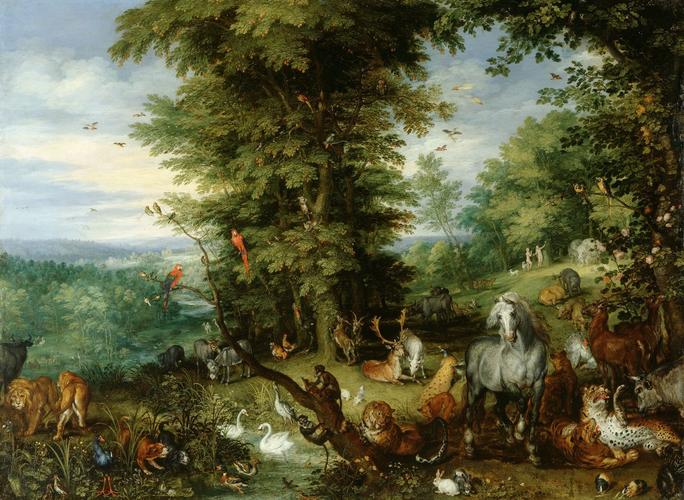-
1 of 253523 objects
Adam and Eve in the Garden of Eden Signed and dated 1615
Oil on copper | 48.6 x 65.6 cm (support, canvas/panel/stretcher external) | RCIN 405512
-
Jan Brueghel was a meticulous but not an unintellectual painter. It is clear that he had a considerable knowledge of natural history and that his paintings were (and may still be) enjoyed as reliable and encyclopaedic accounts of the natural world. As court painter to the Archdukes, Brueghel was able to study botanical specimen in their garden in Brussels and fauna in their menagerie (though, like Rubens, he chose to live and work in Antwerp). Also he had visited Prague in 1604, where he must have seen the more famous menagerie and zoological library of Rudolf II.
According to the Scriptures, the male and female of every species in the world were present in the Garden of Eden, where they had been named by Adam in a universal (pre-Babel) tongue. In theory therefore the whole of pre-Darwinian zoology could be retrieved through a depiction of this subject. This is clearly the spirit in which this work would have been enjoyed; we are invited to recognise and name as many species as we are able. Some of Brueghel’s animals - the horse, lions and leopards - have been copied from paintings by Rubens, but he may have checked them against the real thing or against other images. The elephants perhaps seem to rely on hearsay, but the general standard of zoology is remarkably high.
The animals have sometimes been read emblematically; in particular, the elephants are seen as symbols of virtue in counterbalance to the evil represented by the snake. The kingfisher in the foreground may refer to the peace enjoyed in the Garden of Eden as this bird (genus Halycon) was said in Greek mythology to make its nest on the waves of the sea during times of calm (hence ‘halcyon days’). The scene certainly expresses the more general idea that in the Garden of Eden ‘the lion lay down with the lamb’; in this depiction the leopard plays near the ox and the spaniel befriends the duck.
The landscape here tells us what paradise looked like in the imagination of Brueghel and his contemporaries: soft morning light is seen through an interrupted cloud cover, promising an alternation of sunshine and gentle showers; the rolling terrain is a mixture of clearings and woodland (the trees laden with fruit). The entire landscape of Eden possesses a vivid blue-green colour cast. It corresponds closely with van Mander’s description of the spring written a few years earlier: ‘During the joyful Spring time we should notice the land’s adornment with colours of precious stones, and endeavour to paint the emerald green and sapphire blue cover of the land with its subtle variegation. And through the midst of this let the crystal-clear, murmuring stream meander between its green and grassy banks.’
Signed and dated 1615Provenance
Bought by Frederick, Prince of Wales, before July 1750
-
Creator(s)
(nationality)Acquirer(s)
-
Medium and techniques
Oil on copper
Measurements
48.6 x 65.6 cm (support, canvas/panel/stretcher external)
68.7 x 86.3 x 7.5 cm (frame, external)
Category
Object type(s)
Other number(s)
Alternative title(s)
The Garden of Eden
